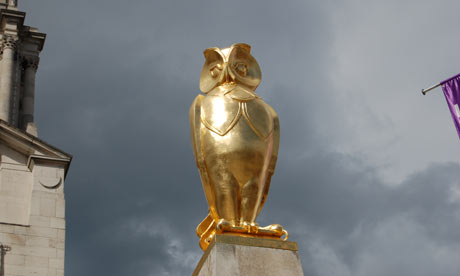
The man who shaped modern Leeds was given an affectionate party last night to launch the book which everyone has long hoped he would write.
John Thorp, officially retired from full-time work but as lively-minded as ever, was the last Civic Architect to retain the title in the UK's modern world of directorates of planning or development.
His title was appropriate because his philosophy is to examine and understand what already exists, looking for ways to improve or enhance it rather than sweep things away and bring in the new. He calls the exercise 'urban dentistry', a phrase which needs to be attributed to him in future dictionaries of quotations, and he has always done it as gently and painlessly as the kindest dentist, even on the city's least promising buildings and townscape.
As a result, Leeds does not reveal a layer of shiny crowns and bridges when it greets you; or, to drop the dental metaphor before it sags under complications, it has hardly any late 20th or early 21st century architectural super-icons. The nearest thing to them is Leeds Met university's Broadcasting Place which, to local amazement (and mostly pleasure), was named the world's best skyscraper of 2010.
This lack of the large and shiny has been an issue with some critics, in the age of Lottery-funded piles. But Thorp can point to instead to marvellous buildings from the past whose iconic status was less assured than it should have been before he came along.
Actually it was Leeds city council's leader Keith Wakefield who did the pointing last night, directing us to gaze from the Banqueting Room windows at the Civic Hall at Millennium Square, the new museum in the old Mechanics Institute, the Carriageworks theatre, the Leonardo Building – all of them Thorp's gentle alteration of familiar city sites which are hugely enhanced as a result.
The room was overflowing, both physically and with affection, because Thorp's gentle approach extends to colleagues, opponents as well as friends in debate and many young people whose interest he encourages unstintingly. His daughter Selina, brought up in this atmosphere, is a flourishing professional artist.
A lifelong devotee of public transport, he is often to be seen around the city, frequently seeking out bits of ephemera from the past for his office walls. These are like some Leeds version of the Sistine Chapel with his paintings, drawings, sketches and diagrams overlapping and flapping from pins and Blutack to illustrate the history underlying his latest notions.
Floor and wall tiles or their fragments play an important part in this exercise. John will usually unearth some from Leeds' lost buildings in any excavations taking place in the city centre. His book continues the story in its title From the Tile to the City. It is absorbing reading for anyone interested in architecture, towns and cities and indispensable for enthusiasts for northern England and, of course, Leeds. More details here.
Here's Thorp, to finish up with, explaining some of his ideas on one of his many, idiosyncratic diagrams of his native city works. As you'll also see, he's not always dealing with the loveliest material. But it is the better for passing through his hands.

